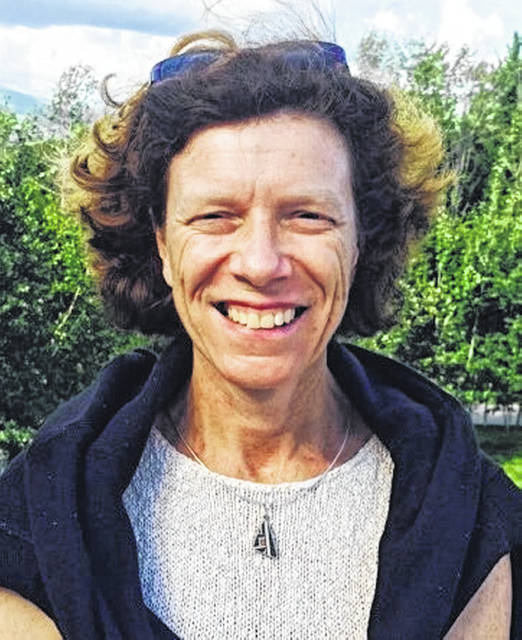
A pandemic that took place a century ago had an impact on the literary arts, which was the theme of the ninth lecture in a series at Ohio Wesleyan University.
“Prior to COVID-19, I had not given much thought to pandemics, and certainly not the idea of pandemic literature,” said Anne Sokolsky, professor of comparative literature at OWU, on Tuesday. She was going to Japan this summer for a project, but the novel coronavirus crisis changed her plans.
Sokolsky said she’s been spending a lot of time outdoors reading from a swinging bench. She did some research and found that indeed there was a lot of literary works with pandemics as a theme.
“Reading for me, especially during this lockdown, has been about answering questions of why we’re in this situation … and also a source of solace,” since she is unable to travel, Sokolsky said. She wondered if we had read any literature during this time, and did it play a role in our current life. Was this role any different than during our past readings?
Quoting former colleague Sally Livingston, Sokolsky said literature can simultaneously serve as a record of the past, power over the present, and an approach towards the future.
“We are living archivists,” Sokolsky said. “Even though we’re not famous, we all have stories to tell about COVID-19.”
After noting that western literature began with a plague from the gods in “The Iliad,” Sokolsky turned her attention to the 1918 pandemic and several writings that are now enjoying a resurgence as a result of our current crisis. For example, Virginia Woolf wrote an essay, “On Being Ill,” and the novel “Mrs. Dalloway;” and poet W.B. Yeats wrote “The Second Coming” and poet T.S. Eliot wrote “The Wasteland.”
She focused on three works. Two were by Americans — William Maxwell’s 1937 novel “They Came Like Swallows” was not previously known to Sokolsky; and Katherine Anne Porter’s 1939 novella “Pale Horse, Pale Rider.”
“It was an interesting experience reading these works on my swing while I’m trapped in my house,” Sokolsky said. “These writers were reacting to the pandemic of 1918. Sadly, there will be more of them in the future.”
Maxwell, editor for The New Yorker, based “They Came Like Swallows” on his childhood experience, where his mother died of the flu in Lincoln, Illinois. It is written in three chapters, each told by a different male character: Bunny, Robert and James.
“I think the novel is about survival, especially when a pillar of the family dies,” Sokolsky said of Elizabeth, the mother.
Porter was a former reporter and Pulitzer Prize winner who drew from her own near death experience from the flu to write “Pale Horse, Pale Rider” (the title is from a spiritual and is referred to in the book of Revelation). Being quarantined interrupted a wartime romance between Miranda and Adam, and an idyllic vision during her delirium seeps into the story.
“I think the novella is about many things, what it was like for a woman reporter when there were few doing such jobs, and a critique of those who use the war for profit,” Sokolsky said.
The flu becomes a character in these fictional works, the protagonist from afar (Spain or Germany) that invades locally, and the authors are survivors who suffered its ravages and guilt. In both works, Armistice Day, Nov. 11, takes on added meaning — the beginning and end of an illness.
The third text discussed by Sokolsky was by Japanese country doctor Gomibuchi Ijirô’s 26-page personal diary, in which he attempted to develop a vaccine in 1919. Sokolsky said this was an example of a different type of writing that takes on a historical and literary quality. She quotes medical writers who have called the booklet “a rare snapshot of the epidemic’s impact.”
Sokolsky said she has hiked in the region of Japan that Ijirô writes of, and she’s thankful that researchers had relatively recently discovered a text that would have otherwise languished in obscurity. She herself just discovered the work a week ago, she said in response to a viewer’s question.
“Not a single one of his patients got sick, and he tested his diptheria serum on himself and every member of his family,” she said of Ijirô. “I’m very intrigued by this idea of medical narratives.”
In reality, the so-called Spanish flu came in three waves over a few months, infected a third of the world’s population, and killed at least 25 million people worldwide, including healthy young adults often by secondary complications and was even contracted by U.S. President Woodrow Wilson. Now called the “Forgotten Pandemic” due to censorship of the time, many people initially assumed this was just another flu and were still dealing with World War I and the Bolshevik Revolution.
For those so inclined, other pandemic texts include: Homer’s “The Iliad” (8th century BCE); Boccaccio’s “Decameron” (1353); Mary Shelley’s “The Last Man” (1826); Edgar Allan Poe’s “The Masque of the Red Death” (1842); Albert Camus’ “The Plague” (1942); Stephen King’s “The Stand” (1978) and Ling Ma’s “Severance” (2018).
Tuesday’s 71-minute virtual class began week five of a 10-week, free online course called “We’re in This Together: An Interdisciplinary Exploration of the Coronavirus Pandemic.” Taught by 24 Ohio Wesleyan faculty members, the course is open to students and the public alike.
OWU spokespersons said more 1,200 people are participating in the class, and more than 350 people are taking part in a Facebook COVID-19 Class Discussion Group.
For more information about OWU’s “We’re in This Together” course, visit www.owu.edu/COVIDclass.


